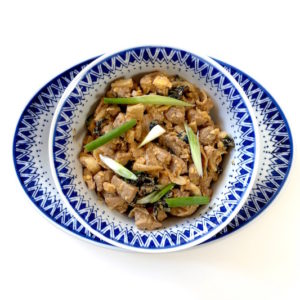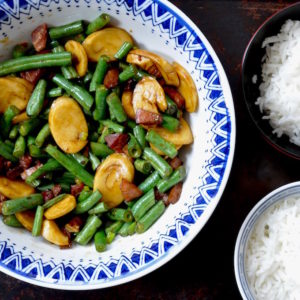Back-in-the-Pot-Pork
My community college photography classmates would have decimated the shot below. After slowly feeding my ego through the wood-chipper for using color film, a choice signaling rank amateurism, the group would have settled in for a nice long discourse about compositional elements. Meaning ninety minutes on the blue rubber band.
Fortunately, none of these people had read Derrida or Baudrillard. Admittedly, neither had I. Sometimes it’s the little things in life.

They wouldn’t have approved of the photo below, either. It’s of my wok. That is, the smaller of my two woks. Yes, I have two. Okay? Yes, okay. Anyway, here in The Insufficient Kitchen, I lack cupboard space, especially storage for larger pots and pans.The woks are sandwiched in a cupboard. The large wok sits at the bottom, while this poor rusted creature in stuck in the middle, where it sings Stealer’s Wheel songs from beneath a wok lid. This lid stands in for any number of other, nonexistent lids. Evidently I wasn’t drying it well enough before cramming it back into the cupboard, where residual moisture had nothing to do but damage its buddy.

I tend to be pretty fanatic about my kitchen equipment. As this wok rusted, I felt embarrassment and an almost anthropomorphic sense of wrongdoing (evidenced by the lunatic sentences up there). And yes, I know how crazy that sounds. (That is, how crazy I sound.) But I hadn’t taken proper care of my equipment. And look what happened to it.
Fortunately, woks are extremely sturdy. Fuchsia Dunlop, my English-language lodestar in matters Chinese food, writes in Every Grain Of Rice:
There is no need to be precious about traditional woks: they are built to be virtually indestructible. Even if the surface has rusted, all you need to do is scrub away the rust with steel wool and reseason the surface and it will be fit for cooking once more.
Nevertheless, I’ve seen woks at the local Goodwill in terrible shape, rusted and ill-treated; they made me shudder. Assurances of indestructibility are no excuse to abuse cooking equipment. After following Dunlop’s reseasoning instructions, below, I carefully tucked the wok beneath an old dishtowel.
So how to rescue a rusted wok? Following Dunlop’s advice, I scrubbed it with hot soapy water and steel wool, down to bare metal–a surprisingly easy task–and placed the wok on a high heat burner, allowing it to get really hot. Then I turned off the burner and poured in about a tablespoon of peanut oil, rubbed it in with a generous wad of paper towelling (take care not to burn yourself), allowed the wok to cool a bit, and repeated the procedure twice. The wok gleamed. I felt much better. Perhaps the meds were kicking in.
Just kidding.

This small wok restored, I went ahead and prepared Back in the Pot Pork–in the big one–and then made cabbage with Chinkiang vinegar in the smaller one before running out of energy and collapsing. (Not really. I did run out of energy. But who has time to collapse? Not you. Not me.)

An honest word about both these dishes. Food prepared in woks is best consumed immediately. While these dishes can be prepared ahead and leftovers store perfectly well, this is food whose vibrant tastes dull rather than deepen over time.

A second honest word: without meaning to kvetch, after a frighteningly dry February, Northern California welcomed “the March miracle,” a four-day rainfest totalling some seven inches. While indeed miraculous, the damp left my tendonitis howling, embarrassingly evident here in the messily hacked pieces of pork belly. You want thin, even slices. Mine are no kind of example–except of what not to do.

About ingredients: Fermented black beans are sold in plastic bags. These semi-dried, salt-preserved black beans must be rinsed before eating, at which point they become little umami bombs. I’ve found fermented black beans at well-stocked supermarkets, but you may need to order them online or visit an Asian market. A few go a long way. Keep your bag well-sealed, and it’ll last forever.
 My bottle of Chinkiang vinegar came from the Chinese supermarket chain 99 Ranch. I’ve never found an adequate substitute and until I bought it, cooked without it.
My bottle of Chinkiang vinegar came from the Chinese supermarket chain 99 Ranch. I’ve never found an adequate substitute and until I bought it, cooked without it.
Update: Today, whilst shopping at my beloved Berkeley Bowl, I scrutinized the shelves of Asian vinegars. Berkeley Bowl carries the full line of Ohsawa Nama Shoyu products, including soy sauces and brown rice vinegars. These are not cheap: use them sparingly, like your finest olive oils. Believe me, one drop is all it takes: I promise you’ll be an enthusiastic convert.
Light Soy Sauce, called for in this recipe, is not the same as “lite,” which is low-sodium. Light Soy Sauce–and thanks to Fuchsia Dunlop’s Revolutionary Chinese Cookbook for help with this definition–is used to add color to dishes, and is in fact saltier than dark soy sauce.
For everyday cooking, I use the soy sauces pictured below. Pearl River Bridge Brand is inexpensive, widely available, and delicious. On the left, light soy sauce. On the right, “mushroom flavor” dark soy. The mushroom flavor is quite subtle. Don’t let it scare you off.
All this said, you need not spend ten bucks on vinegar or soy sauces. The cabbage dish is delicious stir-fried with a little cheap soy sauce, or moving totally out of register, a few judicious drops of fish sauce. Costly bottles of condiments aren’t for everyone.
And if the notion of multiple soy sauces doesn’t appeal, choose one you enjoy and use that.
Cooking is about making ingredients work for you, not vice versa.

Equipment nitty gritty:
Preparing Chinese food differs from preparing Western dishes, with the emphasis on meticulous prep, or what the French call mise en place. After a preliminary parboiling of the pork, you’ll do lots of slicing, peeling, and chopping, with a quick stir-fry pulling everything together. It is critical to have your ingredients ready to go. Happily, this isn’t difficult.
If you don’t own a wok, you’ll need the largest frying pan you’ve got. This pan has to be stable, flat-bottomed, and able to tolerate high heat.
If you do any amount of stir-frying at all, I encourage you to purchase a wok. It’s $25 bucks well spent.
Finally, I adore Fuchsia Dunlop’s three cookbooks: Every Grain Of Rice, Land Of Plenty, and Revolutionary Chinese Cookbook. Dunlop was the first Westerner to study Chinese cuisine at China’s Sichuan Institute of Higher Cuisine, an experience described her award-winning, compulsively readable memoir Shark’s Fin And Sichuan Pepper: A Sweet-Sour Memoir Of Eating In China.
Back In The Pot Pork
Adapted from Fuchsia Dunlop’s Revolutionary Chinese Cookbook
Serves 2-4, depending on how many other dishes are served
Preparation time: approximately one hour: about 40 minutes to parboil the pork belly, the remaining time slicing and stir frying rest of dish
1 piece pork belly, preferably without rind, 14-18 ounces, depending on how many you are feeding. Mine was just over 16 ounces. (see note)
3 scallions, green parts only (I won’t come into your kitchen to count)
10 garlic cloves, peeled (again, nobody’s counting)
piece of fresh ginger, size of your index fingertip, unpeeled
2 tablespoons black fermented beans, rinsed (see discussion of fermented black beans, above)
1 tablespoon light soy sauce
1/2 teaspoon dark soy sauce
1 tablespoon chicken broth or water
2 fresh red chiles, sliced (I used one, as John is not crazy about pepper)
1 teaspoon sesame oil
3 tablespoons peanut oil
Bring a large saucepan of water to a boil. Add the pork belly. Water should cover the belly, so add more if necessary. Turn heat down to lively simmer. Cook until meat is cooked through. Test with a skewer: juices will run clear, not pink. Because my piece was large, I sliced in half for ease of handling. It cooked in 40 minutes.
Drain pork and allow to cool. Once cool enough to handle, trim rind, if it has one, and slice into thin pieces. You want to be able to eat with chopsticks, if, unlike me, you are coordinated enough.
Above step can be done in advance.
While pork belly is cooking, you can prepare the rest of dish.
When I stir-fry, I prep ingredients, place them in small bowls, then arrange them in the order they go into the wok. I would place them near the wok, had I somewhere to put them.
Slice green parts of scallion into fairly longish pieces.
Peel garlic cloves. If they are large, halve them. If garlic is old, you may want to have cloves to remove green germ.
Fuchsia Dunlop find unpeeled ginger more flavorful, so following her lead, I thinly slice ginger unpeeled. You can peel it, if you prefer.
Place fermented black beans in small colander and rinse well. Pat dry with paper towel. Be careful, as beans like sticking to towel. Place in small bowl.
Measure soy sauces into small bowl.
Measure chicken broth or water into small bowl.
Have the chiles ready.
Place the wok on the burner. Heat until it starts smoking (you might want to open a window or turn on your exhaust fan). Pour in about a tablespoon of peanut oil. Stand back; it may spatter. Reduce the heat to medium. Add the garlic and ginger, stir-frying until they begin browning. Add pork, stir-frying until meat begins coloring, separating, and is quite fragrant.
Tip in the beans and soy sauces. Continue cooking, adding the broth or water. If contents of wok look dry or stick, add more water or broth.
Add chiles and scallions and give them just a couple turns; you want them barely cooked. Turn off the heat and add the sesame oil. Serve with Hand-torn cabbage with Chinkiang vinegar and plenty of rice.
Notes: My market sells pork belly with and without rind. This time the belly had rind, which was much easier to trim after parboiling. I allowed the belly to cook and cool before sliced the rind off.
Rind can be saved for soups and stews, to line terrines, or make confits.
This next recipe happened because we had half a cabbage in the fridge. It’s easily scaled up.
Hand-Torn Cabbage with Chinkiang Vinegar
Adapted From Fuchsia Dunlop’s Revolutionary Chinese Cookbook
yield: Two servings
Amounts easily multiplied
Prep time: approximately 15 minutes
1/2 large cabbage
1 large clove garlic, minced
1 scallion, trimmed and sliced
1 small piece ginger, thinly sliced
2-3 dried red chiles
2 tablespoons peanut oil
1-2 tablespoons Chinkiang vinegar, Nama Shoyu Vinegar, soy sauce, or fish sauce
Tear the cabbage by hand, discarding the core. Or slice into ribbons.
Cut open the dried red chiles and discard seeds. If you are sensitive to heat, use gloves. Avoid touching your eyes, especially if you wear contact lenses.
Peel and mince garlic. Slice scallion. Thinly slice ginger. It is okay to leave the peel on.
Heat the wok over high heat (you may wish to open a window or turn on the exhaust fan). Add peanut oil and turn heat down to medium.
Add garlic, ginger, and scallion. Stir fry until aroma rises. Add the cabbage and cook, stirring constantly, until it begins cooking down and browning at the edges, 3-4 minutes.
Push cabbage up the wok and add dried chiles to bottom, allowing the cook a bit in the oil.
Stir everything back together, turn off the heat, and add the vinegar/soy/ fish sauce. Serve immediately.





